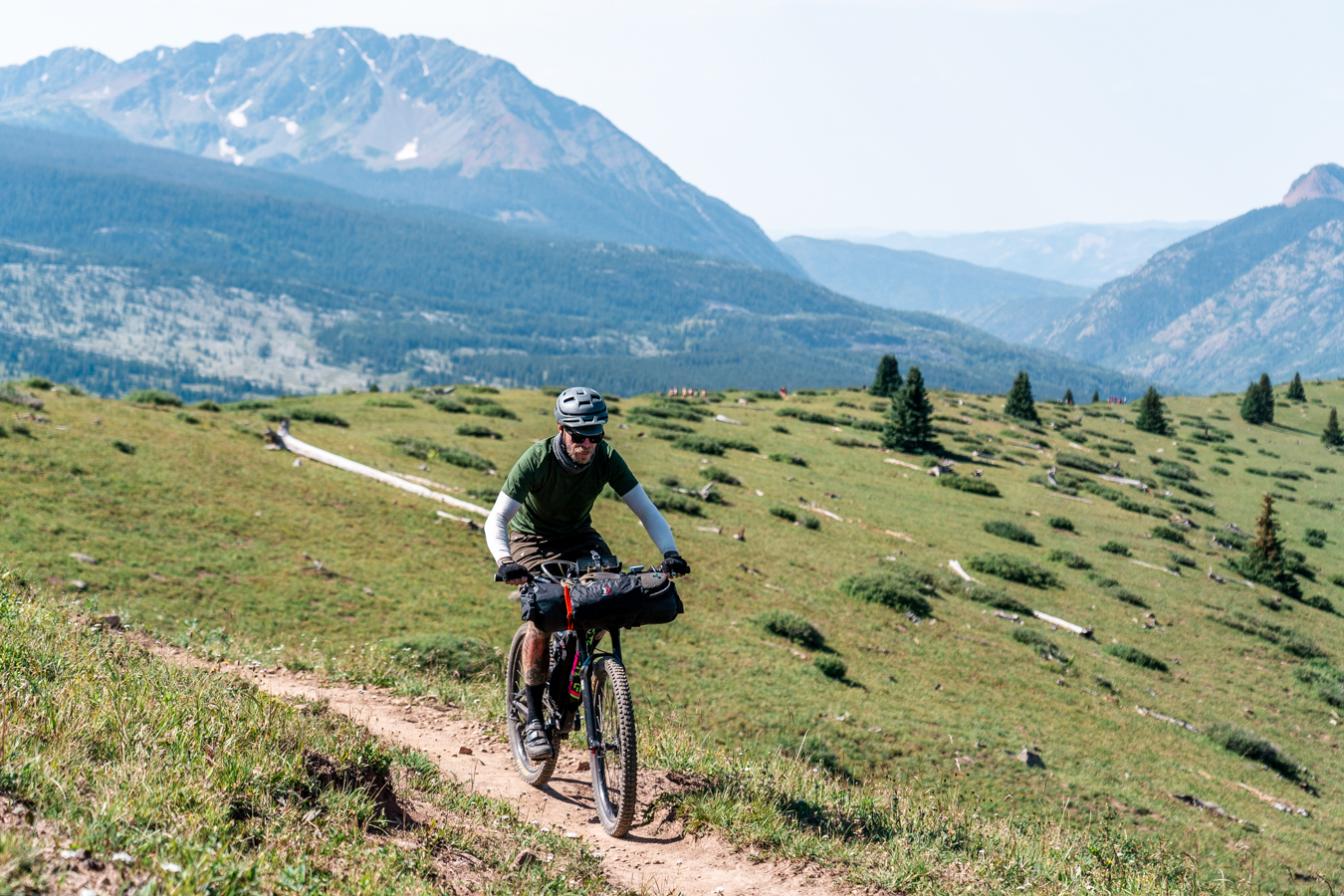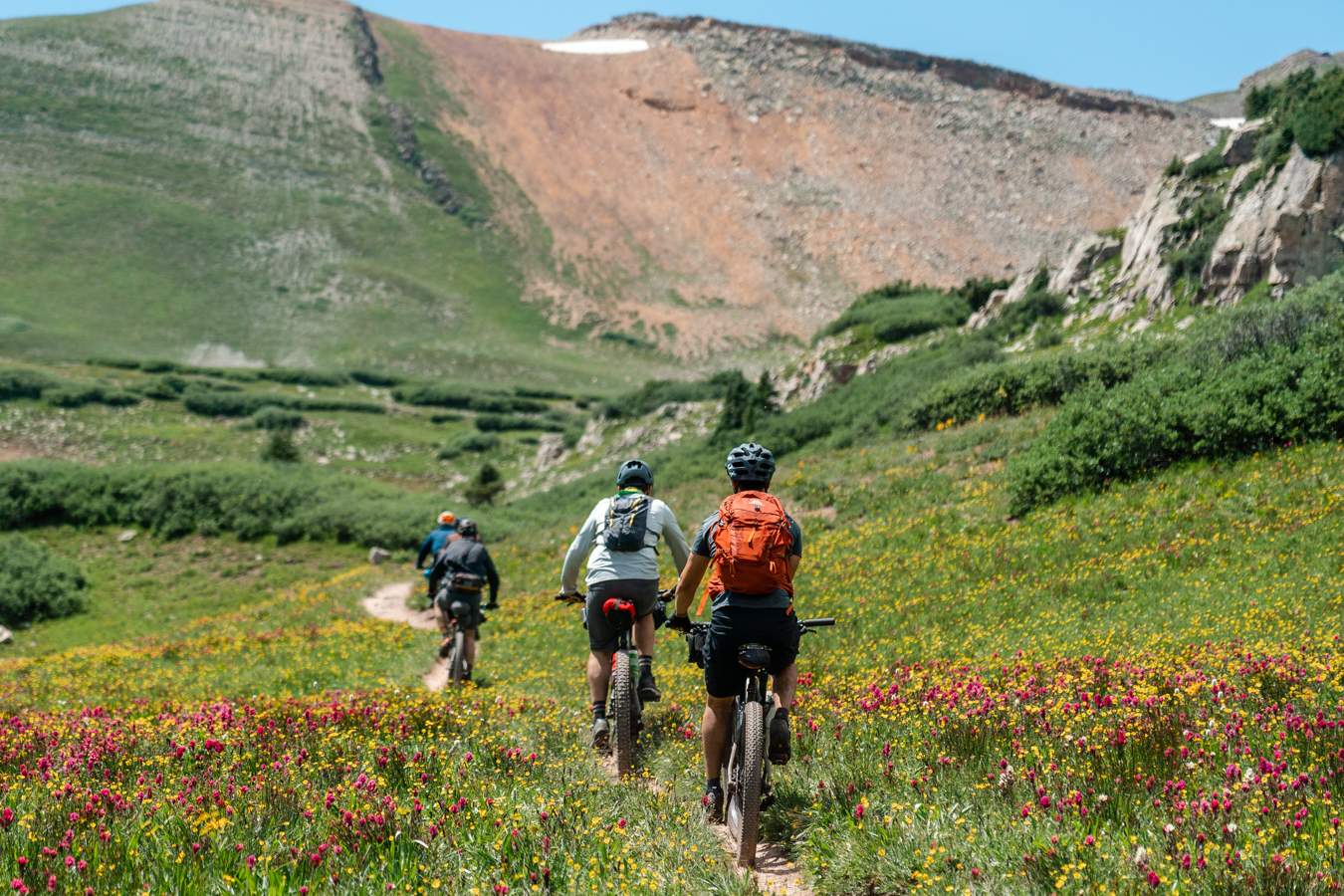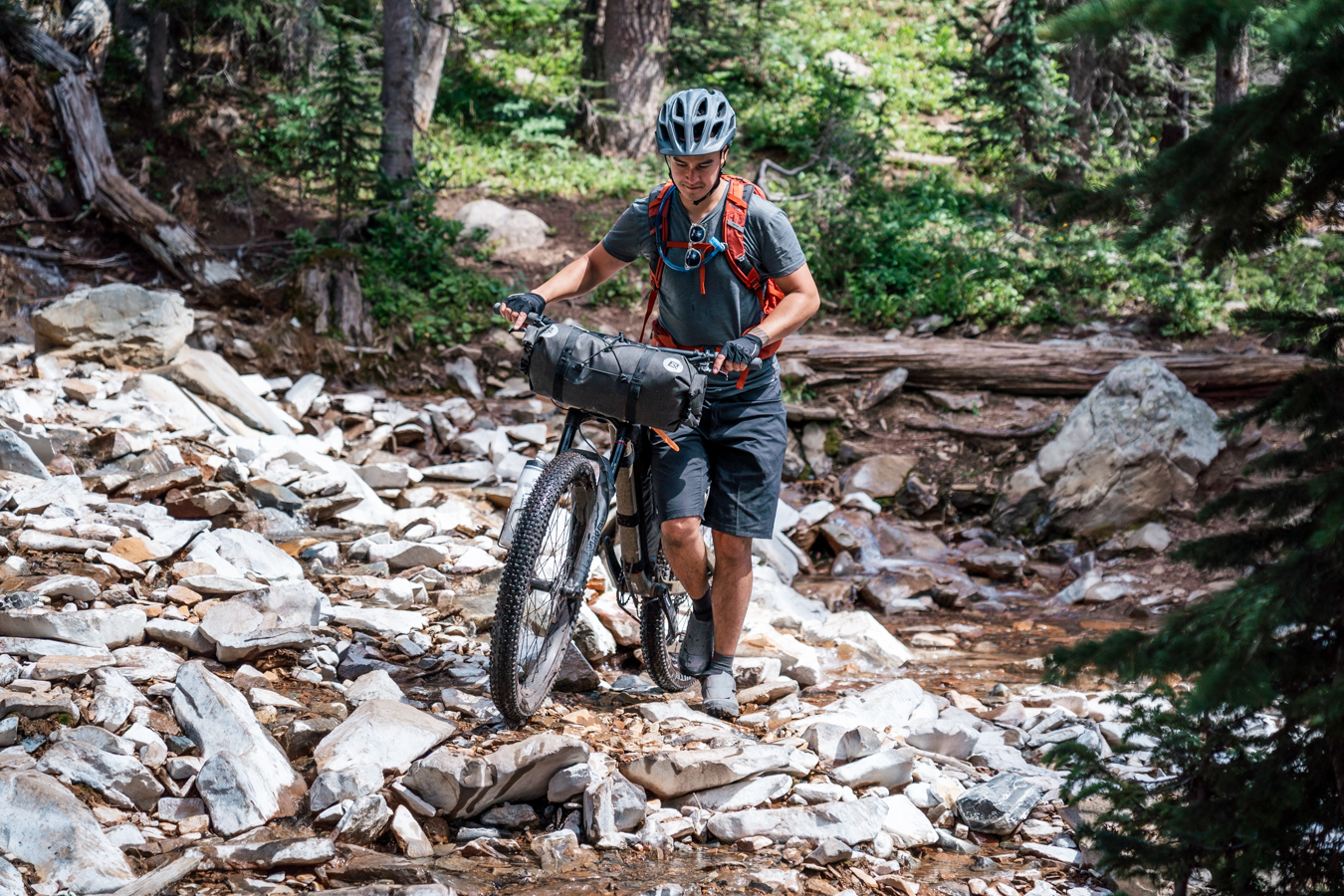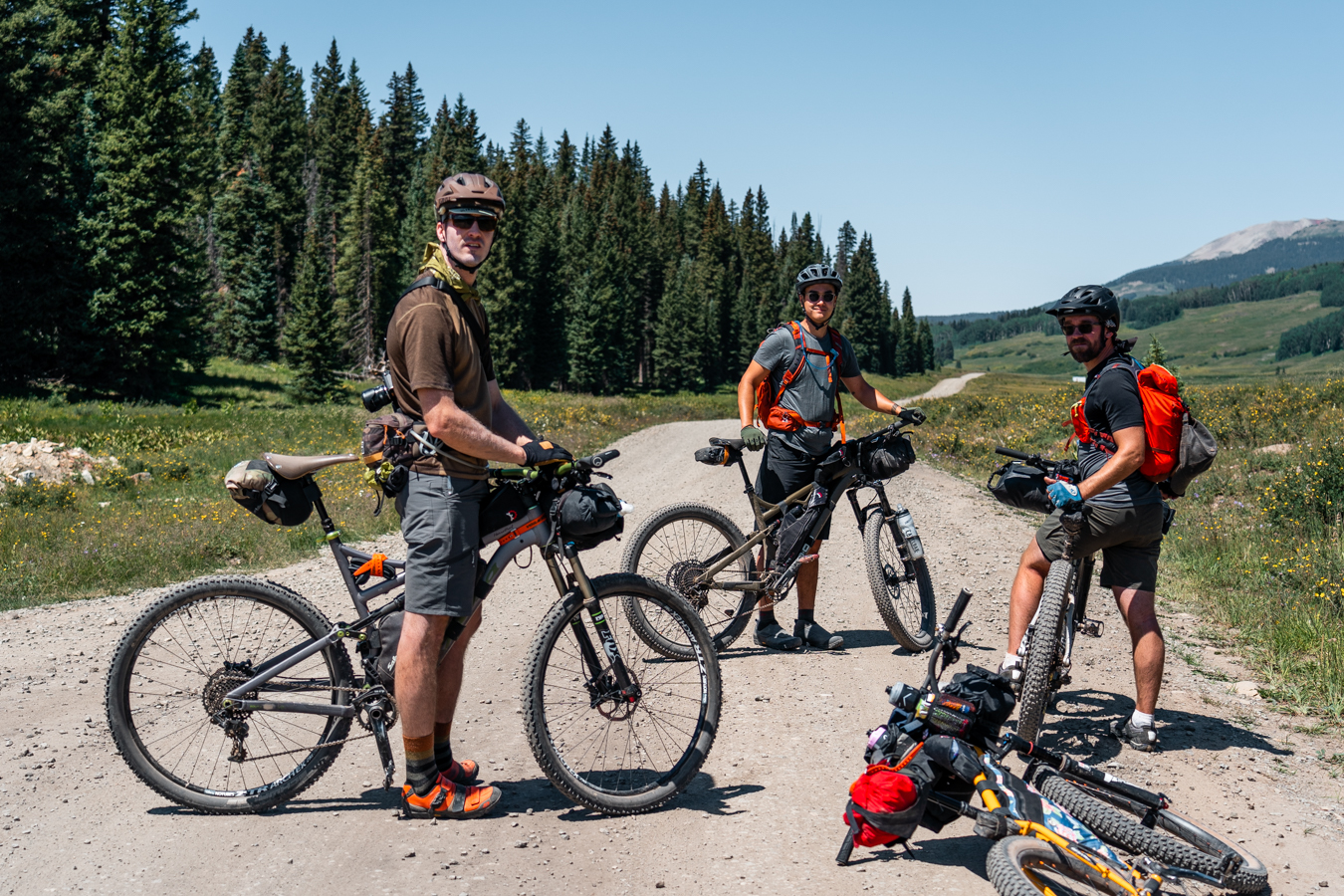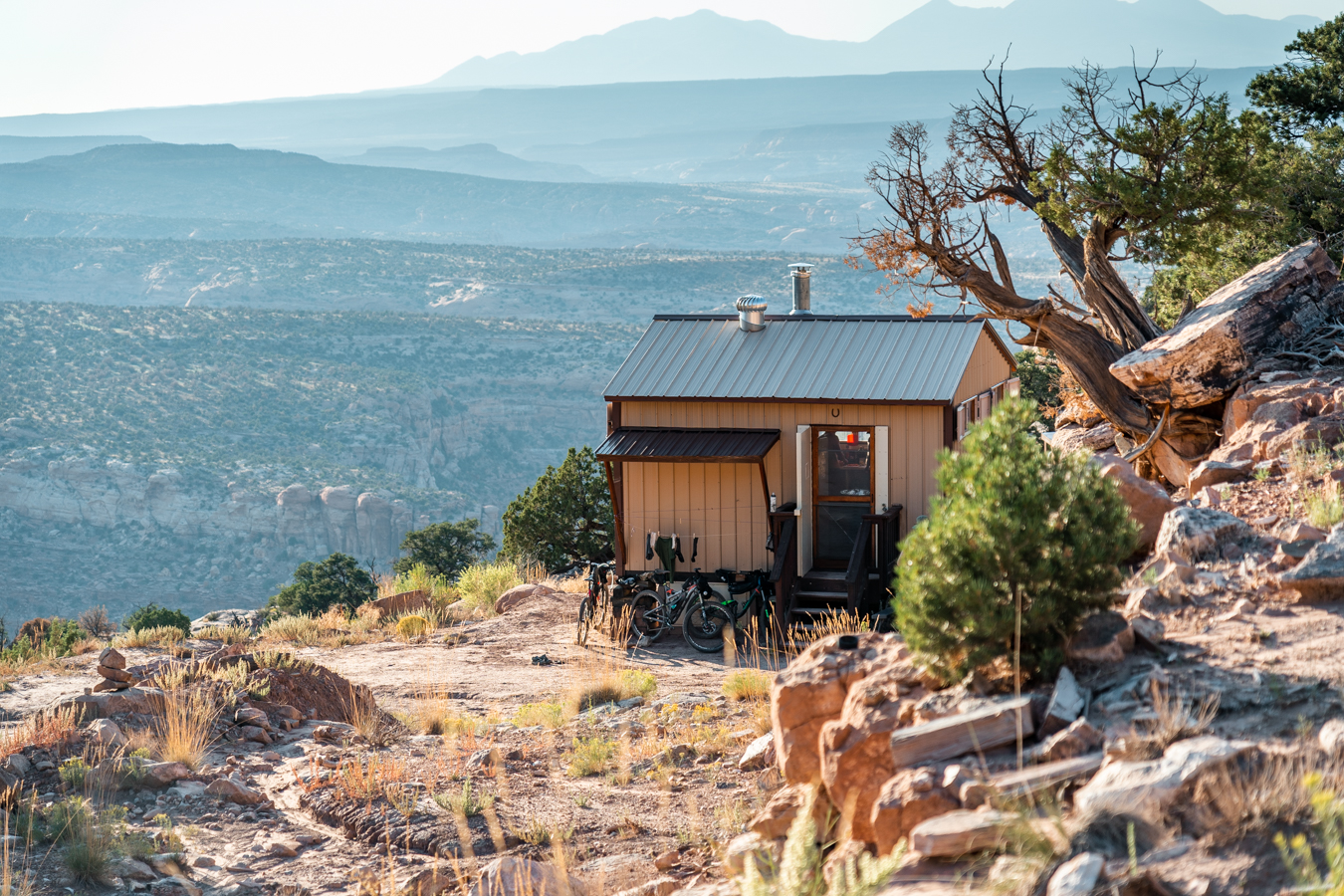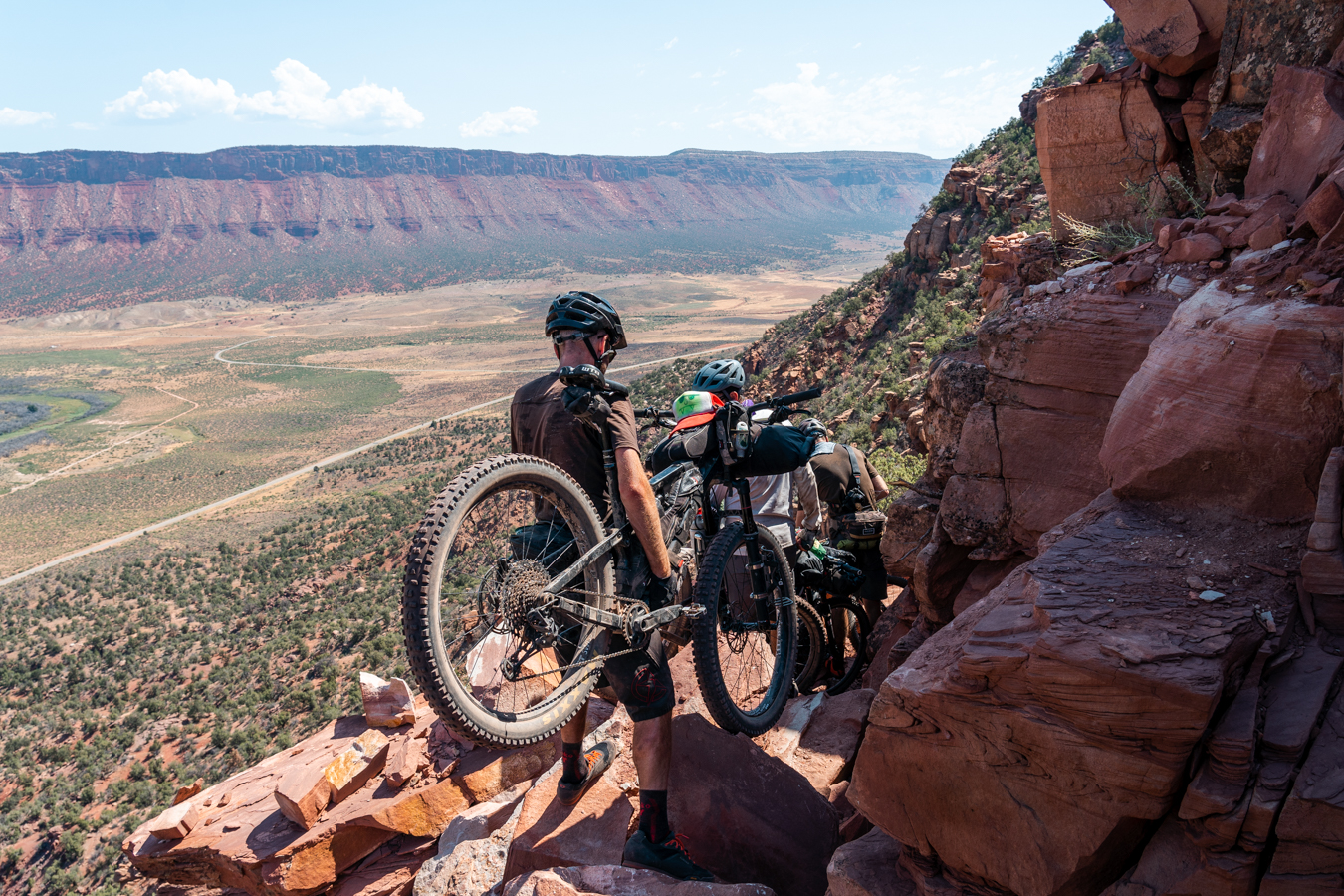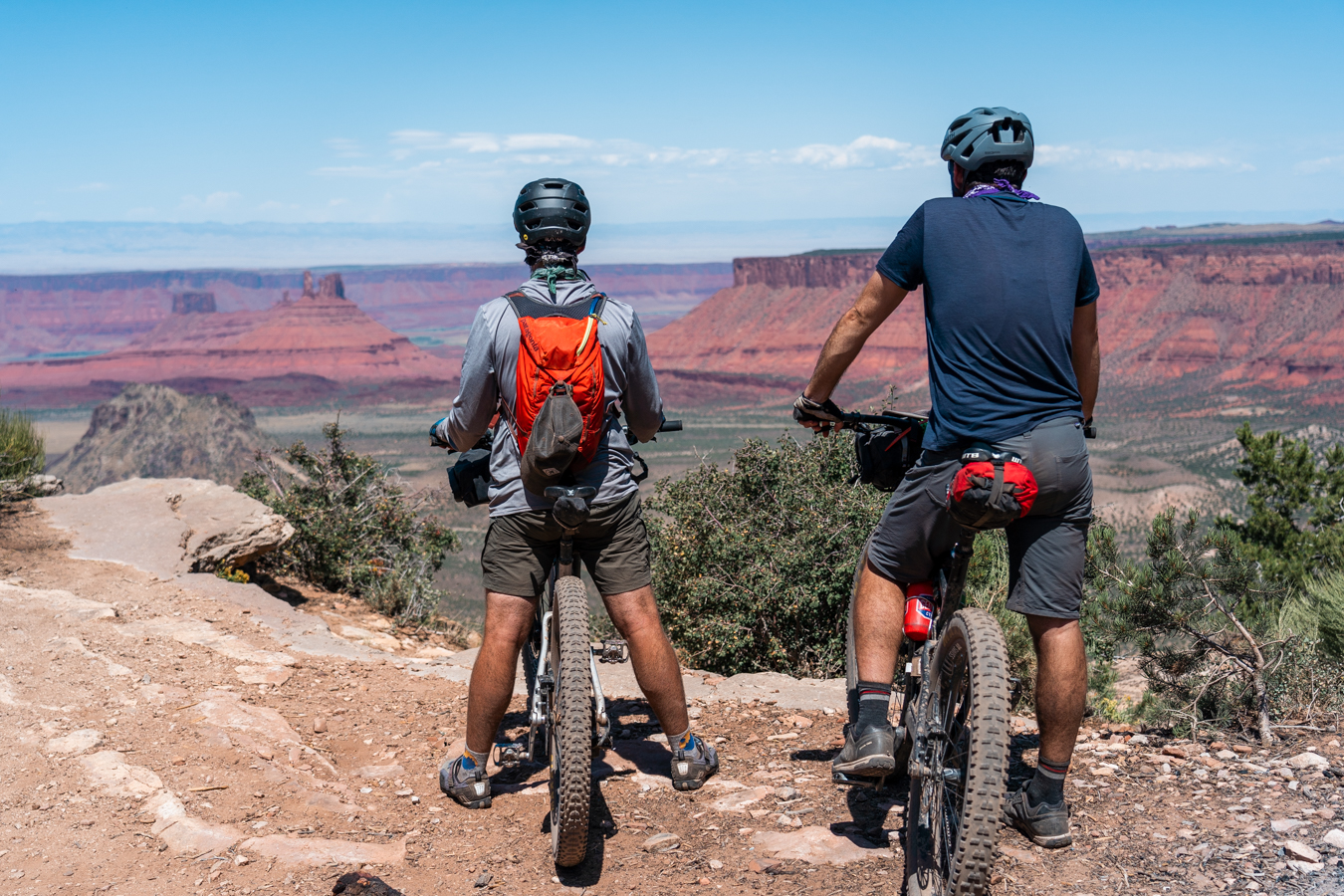It’s not long after we’ve packed all eight of our bikes and a weeks worth of gear to be loaded in the Western Slope Rides shuttle van in Moab, Utah, that Robert Warren, our driver, has us all rapt and pinned to our seats.
Not so much for the quality of his driving, which is nonchalant on hair raising roads that seem like he could navigate blindfolded, in a converted Econoline that had long ago eclipsed 400k miles, but for the tapestry of his stories. They range from bold rock climbing first ascents in the vaunted Black Canyon of the Gunnison, where he had grown up, to sustaining grisly injuries while traveling in far flung corners of the globe- requiring emergency grindhouse-film medical procedures that would allow him to keep his limbs and appendages, to the fringe metaphysical concepts dealing with time, gravity and physics. Robert, it would seem, in addition to embodying that protean, suntanned and sinewy mountain man with a dozen close-call stories, had spent the bulk of his more formal professional life as a bonafide geophysicist. Now piloting this shuttle van through the hairpin backroads of one of America’s most richly abundant geological regions had provided Robert with a captive audience of 8 at a time for him to enthrall us with the vast scope of his scientific expertise, as well as serve as strata guide, as we ascend out of the blistering hot desert, through the ages of geological upheaval, toward the end of our class session that day, four hours and 175 miles later to the launch point for our MTB adventure- a week long semi supported hut-to-hut trip through the heart of the San Juan Mountains of southwest Colorado, back to the iconic sandstone desert of Moab, Utah.

Silverton, once a gritty mining community, embedded deep in the San Juan Mountains of southwest Colorado, has evolved over the years, like many a mountain town to become a destination for outdoor recreationalists, eager to step off the beaten path. The summer months lend themselves to anglers, backpackers and mountain bikers, and in the long and snowy winter months, this area is a benchmark for backcountry powder hounds. The swing-door saloons and mercantiles of the late 19th century have been reimagined as beer gardens and gear stores. Instead of a hitching post for your horse out front, you’ll find a staple rack for your townie klunker or plush trail machine. Silverton doesn’t have that polished, posh vibe that other Colorado mountain towns have. The buildings here are weathered and ooze authentic, patinaed mountain town charm. Many of the streets are unpaved. More pickups than Range Rovers, and while there is certainly a seasonally pronounced tourist element that makes the local economy hum, you get the sense that the locals are dug in on keeping this place somewhat of an isolated gem, whether the secret is out or not.

Arriving to the Aladdin’s Lamp Cabin outside of Silverton, the tone for the trip is set. The spartan A-frame cabin is modestly equipped with a wood burning stove, a water line to a spring below the property that provides us with frigid, crystal clear water, as well as a composting toilet pleasantly isolated from the main living quarters. Additionally a solar panel, mounted adjacent to the cabin feeds enough electricity to power a few interior lights and a couple USB outlets that we utilize for phone charging duties and operating a small bluetooth speaker- a necessary accessory for a group of 8 with varying but robust musical proclivities. Townes features heavily that first night. Situated amidst a stand of tall pines, below a towering hillside capped with rock crags and pinnacle features, it’s iconically Rocky Mountain and affords us sweeping vista views from our deck of the San Juan Range standing tall and proud above the valley below. It’s during a short walk to an abandoned mine across the road that the scale of the range surrounding us takes hold, as well as the altitude. The casual incline to the rustic structure leaves us all slightly winded. The evening hours provide an opportunity for the eight of us to sort out some gear, tinker with bikes, and sip on a few beers while examining some route maps and relief profiles. Preparations feel complete before turning into our bunks in the loft, anxiously dreaming of the next day when we set out on our seven day trip through a wide swath of remote terrain, and across barriers geographical, as well as physical and psychological.

As is often the case with these undertakings, the onset and conclusion of our trip would be shared with the greatest number of fellow adventurers, due in no small part to sheer proximity to population centers- a factor we effectively abandon after day one. There’s an exhibitionist element to departing and arriving where we feel on display for onlookers who happen to be occupying these spaces with either similar, or often less ambitious goals and itineraries. A quick eye check to ensure I’m properly equipped and exuding the requisite mettle. The trailhead at Molas Pass is no exception and our first few miles on the trip are shared with day users of the heavily traveled Colorado Trail, including a local high school girls cross-country team, out for a weekend training run, who easily out pace us, and manage to humbly and thoroughly put into perspective our lack of acclimation to the high country.

Day one thoroughly impresses, with stunning mountain landscape vistas, traveling the revered Colorado Trail, we flank placid alpine lakes and endless rolling meadows strewn with a technicolor spectrum of wildflowers. Having to get off our bikes numerous times to offset the effects of altitude or obstacles in the terrain, we keep our heads up and look around us, often in awe, and proceed to 12,000 feet and Rollins Pass. It’s there that we encounter a massive herd of sheep, seemingly all shepherded by a lone intrepid dog. The group presses on and descends the steep rutted trail at a fast but calculated pace through the Cascade Creek drainage, and then up and out again above Tin Can Basin. Feeling the effects of a full day spent at or above 10,000 feet made the sight of our first hut that late afternoon a welcome one.

The San Juan Hut system operates on federal, state and private lands to provide travelers with an option to complete the Durango to Moab or Telluride to Moab routes with modest creature comforts and a measure of ease. Essentially two trailers joined and set in a fixed location, the huts are comfortably equipped with bunk quarters for up to 8, sleeping bags, wood stoves in the higher elevation locations, two-burner gas stoves, and lockers bountifully stocked with an assortment of canned and dry foods as well as two coolers stocked with perishables (eggs, bacon, butter, tortillas, as well as some fresh vegetables) and libations (canned beer/wine/cider, sparkling waters.) The sheer quantity and variety of foods available to travelers utilizing the huts are staggering. Eliminating the need to carry a week’s worth of food and cooking necessities allows us to keep our loads paired back, and the spacing on the huts is such that reasonably fit and capable riders should have no trouble preparing a meal in the morning before departing for the day as well as considerable time in the evening to unwind and do the same. In essence the San Juan Huts have gone through the trouble of creating a daily destination for travelers undertaking a prescribed route that affords them the ability to travel light and fast, focus on the beauty and experience of the route and the landscape; thus eliminating the stresses of route finding, scouting a place to pitch a tent for the night or the necessity to carry bulky cooking, food and sleep supplies.

The added simplicity of the hut system is that all of the huts along the route are set up nearly identically, so you know what you will be arriving to, and by the end of the week we are dialed in our routines with everyone pitching in to provide a helping hand in our newly adopted domesticated roles. Some of those roles are fallen in to more naturally than others. We quickly flesh out who the natural chefs are in the group, and we eat surprisingly well morning and night. It’s clear who would prefer to help with prep or dish detail, or gather firewood and kindling, or who can lend a hand with simple bike maintenance issues or DJ on the Bluetooth speaker that Nolan was gracious enough to lug in his handlebar roll for a full week. We’re a collective in that regard, playing to one another’s strengths and appreciating what each of us in the group contributes to the trip and the dynamic. There’s never any drama or hostility. There’s a ton of laughs and stories. We figure out how to take space from one another, whether it’s in or around the huts in the evening, or throughout the course of the day while on the route. Through the stresses of a week-long trip where you’re covering a ton of ground, and succumbing to fatigue and altitude, and poor sleep, or hangovers, or saddle sores, or dehydration, you have to maintain that levity and perspective that you’re supportive of one another; that your pains and triumphs are shared and understood, whether spoken or unspoken.

The trip unfolds like this. Each day is a different chapter to a larger story; beginning and ending largely the same. The scenery changes- at times drastically. The mercury climbs to uncomfortable highs as we get to lower elevations. We ascend a great deal, getting stronger every day, and then we descend, sometimes for miles on end, careening down forgotten forest service roads or scarcely traveled two-track. The colors and the vegetation shift. We move through alpine tundra, dodging afternoon storms, at times being able to see beyond entire ranges and valleys, constantly looking west towards the next day. We traverse through massive quaking aspen groves and through fertile pastures, only occasionally encountering other people, more often than not when we’re forced to cross or travel a major road do we get any real return to civilization. We stop to swim and bathe in reservoirs and filter water to drink from pristine creeks. We take several recommended detours to the standard route to swashbuckle our way through primitive and overgrown singletrack. We spend an entire day navigating an endless labyrinth of gas mining two-track, caking ourselves with dust and pulverized sandstone, finding a brief respite from the intense afternoon sun at an urgently felt, strategically placed water drop under the shade of a stand of juniper trees.

What I will say for the route from Silverton to Moab, is that none of it feels contrived or redundant. Each day feels necessary and unique from the rest. Each day bookended with a thoughtfully spaced shelter, dropped methodically in a locale that would provide us with amazing views and a logical starting and ending point for our days. The evening hours unwind with self-reflection, relaxation, and immersion in photogenic color shifts. The sage in the underbrush turns to chrome while the western horizon shifts to bright orange and then rust before casting the sky lavender, giving way to the ink of night when we take a crack at identifying and conjuring constellations amidst a sea of stars. The Milky Way is clearly discernible. The moon rises and we don’t need headlamps to wash dishes or amble out to a canyon rim or around the bend for that noir valley view. We’re constantly reminded of the cosmos in these places. Light pollution doesn’t exist out here.

Day 5 has us departing the Wedding Bell hut, after romancing each other the evening before with a sunset dinner next to a canyon rim overlooking the Dolores River a few thousand feet below. Tom made his now-famous salmon cakes again. The whole experience along with the views were a little surreal- and rivaled anything I’ve experienced at more iconic canyon locales. The group presses on towards the Paradox Valley, where we’re in for a little mix-up to the routine. After a somewhat casual day of traversing the plateaus above the basin, we approach the Catch-Em-Up trail- a mile long, mandatory hike-a-bike descent of 1,000 feet that had recently experienced a pronounced infill of rockfall resultant of a fairly intense earthquake in the region. At this point in the day, it’s peak sun and approaching mid-90s and the task of getting the bikes down the trail is grueling, and at times frustrating and risky. Short segments require passing our loaded bikes to each other carefully downhill across talus. It’s evident that these are the circumstances that lead people to take a spill, twist an ankle, throw their rig, and curse at the sun. But we press on, motivated with the knowledge that, at the bottom of this godforsaken trail is the famous Bedrock Store.

Anthony Pisano is in the process of rehabbing the decking on the room above the Bedrock Store when we arrive. He waves us in and applauds us for our immense bravery or stupidity in descending into Paradox Valley with the thermometer approaching triple digits. Anthony wants to tell us a colorful story or two while we browse his shop and discerningly select frozen ice cream treats and salty snacks. Anthony is built like a college wrestling coach with the hands of a pugilist. We soon find out that he relocated to this valley of 100 people from a Brooklyn steelyard about ten years prior to operate this store that has functioned as a general store in this valley for over a hundred years. He was destined to do this, he explained to us with no irony. It’s maybe 5 minutes into our interaction with Anthony Pisano that he drops his guard and the full thickness of his Brooklyn accent comes pouring out and if you were to close your eyes, it would require little to no imagination, picturing his syntax emanating from a Scorcese film, four-letter expletives and all. If the Bedrock store ever goes belly up, Anthony could make ends meet doing talk radio or televangelism. He is that raw and unbridled soul, so full of piss and vinegar and natural comedic flair and personality that he will find himself an audience and someone to bear hug, anywhere he goes.

From Bedrock it’s a gradual gravel road climb to Paradox Hut, where we have enough time to drop our rigs and pull together some personal items for the rest of the afternoon and evening, that we’ll spend at Paradox Mercantile, where we’re provided the luxury of enjoying the outdoor shower on their property, basins, and clotheslines for laundry detail, some access to WiFi and power outlets, and the real icing on the cake- a superb home-cooked farm to table meal made by Greg’s partner Marty. Marty and Greg have spent years in Paradox Valley, creating an organic farm on the property adjacent to the cafe, where they yield enough produce to sustain themselves and other folks of the Paradox Valley, but also to neighboring community farmer’s markets. In addition to their produce, and beekeeping duties, they’ve graciously carved out a niche providing hospitality to the riders utilizing the San Juan Hut system routes. For a nominal fee, they open up their property to us for the evening and make us feel at home and facilitate some creature comforts that have been in short supply for a few days. It’s immediately evident that Greg and Marty appreciate the company and diversity of the riders they encounter as much as we appreciate the amenities. You can sense in them that they’ve made sacrifices to carve out the life they have, and there is tremendous humility and selflessness in them both. The meal they provide is filling and nourishing and our conversations are rich and stretch on into the night. It’s well after dark when we hug Marty goodbye and pile into the back of Greg’s truck and watch the taillights illuminate our dust along gravel roads through the valley, back to Paradox Hut. A thunderstorm in the distance and a pack of howling coyotes round out the desert soundscape, lulling us effortlessly to sleep, sated and grateful for all of our new Paradox Valley friends.

Departing Paradox Valley, we get an earlier than normal start to the day in an attempt to beat the heat during our arduous climb towards Geyser Pass and the La Sal mountain range. That sixth day is a slog as we gain 5,300 feet over 22 miles. A constant uphill battle, but we make short work of it, pausing for a celebratory nip of whiskey at the Colorado/Utah state line. That last night in the huts has us nestled in an aspen grove on private ranch land, cattle out to pasture, sharing one hell of a view of the La Sal’s while they roam freely across countless acres of Redd’s Ranches. It’s there at Geyser Pass that we encounter the trip’s only real taste of inclement weather, as high winds carry a small rainstorm and much cooler temps through on our last morning, only briefly delaying our final uphill push toward Burro Pass and the crest of the La Sals. The shower offers us a welcome excuse to linger, sip more percolator coffee and watch the cows take cover beneath the aspen trees.

Cresting out at Burro Pass, climbing for the trip is essentially done as it’s a proper gravity feed on that last day as we descend over 7,000 feet. The temperature swing is as pronounced as it had been all week- departing Geyser Pass in light rain that could easily have turned to snow, was a stark contrast to the 100-plus degree heat we encountered when we finally rolled victoriously into Moab later that afternoon. It had been many years since I had ridden on either the Kokopelli or Porcupine Rim trails- a couple of rollicking test pieces that get checked off the tick list for mountain bikers- both domestic and international alike. It’s a fitting culmination to the trip and a poignant bookend to the high alpine riding of the Colorado Trail that we enjoyed on day one. After a few high intensity hours of getting bucked around in the punishing sun, low on water, dealing with some of the trip’s only mechanical difficulties, and thoroughly depleted from seven straight days of riding, a few of us catch a bailout spur off Lower Porcupine and pick up the Sand Flats road, high tailing it the rest of the way back into Moab, robbing ourselves of the illustrious Full Enchilada complete- a specious disappointment that’s quickly diminished with burgers and shakes at Milts.

On paper, our week-long hut trip beginning in the San Juans of Colorado and ending below the La Sals of Utah required the eight of us to travel roughly 215 miles, climbing and descending nearly 25,000 feet. Ultimately, it also required the eight of us to find a ton of humility and confidence in ourselves and to let the trip bring out the best in each other. Along the way, I think we were each able to slow down in a moment and absorb the beauty and diversity of the landscapes that we encountered and appreciate the opportunity to experience those places from the saddle of our bikes. Additionally, I know I speak for all of us when I say we are particularly grateful to the dynamic and generous souls we encountered along the way, who through their willingness to open themselves up to us and share their stories and their lives and the land they call home, added a dimension and an earnest appreciation to a truly memorable adventure.
San Juan Huts will email you the appropriate file for their 4-night/5-day or 6-night/7-day trip once you sign up at their website. Please respect the San Juan Huts’ system and do not poach the huts.





